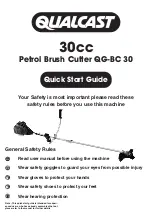
EN
43
for the blade fixed in the protection of
cutting accessories.
4.6 - fUEL (fIG. P)
The engine must run on a mixture of
unleaded gasoline and 2-stroke engine
oil in the proportion of 1: 40 (1 liter of
oil for each 40L of gasoline).
1. Place the 2-stroke engine oil in a fuel-
approved tank;
2. Add gasoline to 2-stroke engine oil;
3. Place the tank cap and shake it
thoroughly to mix the oil with gasoline;
Unsuitable fuels or with a different
proportion than recommended may
lead to irreversible damage to the
engine. Gasoline or oil of inferior
quality can damage the engine, sealing
rings, hoses and the fuel tank.
Keep the fuel mixture in proper and
adequate tanks in a safe, dry, cool
place protected from sunlight. The
fuel mixture ages; mix only the amount
needed for a few weeks. Do not store
or use fuel with more than 30 days.
Shake the fuel tank before
refuelling.
Pressure may form inside the
tank, for this reason it shall be
opened carefully. Avoid direct skin
contact and inhalation of flammable
vapours.
When refilling the fuel tank (35), do not
add gasoline above the maximum level
of the filler nozzle.
5. MAInTEnAnCE
AnD CLEAnInG
InSTRUCTIOnS
Before any maintenance or
cleaning work, place the
equipment on a levelled surface, unplug
the engine and pull the spark plug cap.
Never touch the exhaust, spark
plug, or other metal parts of the
engine while the engine is plugged in or
immediately after turning off the engine.
This can lead to severe burns or electric
shock.
5.1 - SHARPEnInG THE
CUTTInG DISCS
For a maximum performance, to avoid
the risk of impulse and to extend the life
of the machine, maintain and always
use discs with sharp teeth. A badly
sharpened or damaged disc increases
the risk of an accident.
See the disc package for proper
sharpening instructions. Use a flat file
to sharpen the discs. Sharpen all edges
evenly to maintain the balance of the
disc.
Never attempt to straighten a deformed
disc so that it can be reused.
Always dispose of a disc that is bent,
twisted, cracked or damaged.
5.2 - CLEAnInG THE AIR
fILTER (fIG. Q)
The air filter should be cleaned
regularly. Dirty air filters decrease
engine power, increase fuel
consumption, hamper start-ups, cause
carburetor malfunctions, and cause
engine parts wear.
1. Rotate the air inlet regulating button
(26) counter clockwise. This avoids
the entry of waste into the carburetor
when the filter element is removed;
2. Untighten the tightening screws and
remove the air filter cover (34);
3. Remove the filter element and
blow it with compressed air until it is
completely clean. If it does not allow
an efficient cleaning or it is damaged,
replace it;
4. Insert the filter element and
assemble the remaining components in
the reverse order of disassembly;
Using a dirty filter will restrict
the airflow in the carburetor
affecting the engine performance.
5.3 - CLEAnInG THE fUEL
fILTER (fIG. R)
1. Empty the fuel tank (35);
2. Remove the fuel hose from the tank
and remove the filter (36);
3. Blow the filter with compressed
air until it is clean. If it does not allow
effective cleaning or is damaged,
replace it;
5.4 - CHECKInG AnD
REPLACInG THE SPARK PLUG
(fIG. S)
To ensure a proper engine operation,
the spark plug must be clean and
with adequate distance between the
electrodes.
There are several factors that can
affect the operation of the spark plug:
incorrect carburetor adjustment and
fuel mixture, and dirty air filter. These
factors cause deposits in the spark plug
electrodes, which leads to operating
problems and difficult start-ups.
If the unit has a low power or troubles
when starting, check the spark plug
before making any further checks.
1. Untighten the fixing screw and
remove the spark plug protection cap
(37);
2. Remove the spark plug cap, untighten
the spark plug with the supplied wrench
and check if it is clean. If dirty, clean the
soot with a brush;
3. If the spark plug is “soaked” with
excess fuel, place a clean cloth over the
spark plug hole and pull the starter grip
several times without the spark plug;
4. Measure the distance between the
electrodes with appropriate tools. The
















































